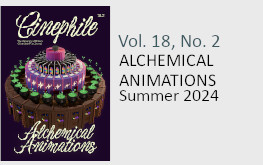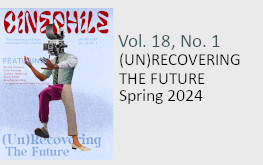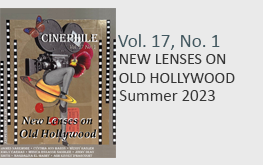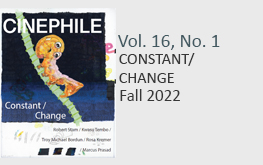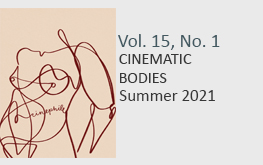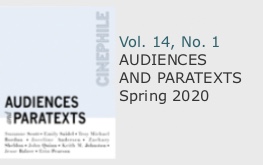Barry Keith Grant
excerpts from a work in progress
This book examines issues of gender and identity, with an emphasis on the representation of masculinity, within a historically wide range of Hollywood genre movies, ultimately countering the accepted wisdom within film studies that particular periods and films represent a crisis in the American male psyche. Through a series of close readings of selected genre movies and directors, I argue that to understand the history of American cinema as a series of masculine crises is a serious distortion of both Hollywood filmmaking and its genres, and that, in fact, genre movies constitute an ongoing dialogue with their audiences about gender definition.
According to genre theorist Steve Neale, in the cinema “…there is constant work to channel and regulate identification in relation to sexual division, in relation to the orders of gender, sexuality, and social identity and authority marking patriarchal society… Every film thus tends to specify identification in accordance with the socially defined and constructed categories of male and female” (11). After Laura Mulvey’s breakthrough article on “Visual Pleasure and Narrative Cinema” in 1975, feminist critics began to understand that masculinity, like femininity, may have been the center from which Others were defined, but it was not simply one uncontested construction. Quick to look for cracks in the previously assumed monolithic representation of masculinity, critics melodramatically identified moments of ‘crisis’ in its representation. For example, film noir, which flourished in the 1940s and 1950s, is understood by scholars today as being largely about the acute sense of disempowerment men felt returning home from World War II to find that during the war women had left the domestic sphere and entered the workforce in unprecedented numbers. Masculinity in film noir is often depicted as a struggle for the male protagonist to maintain his heteronormative identity. As Frank Krutnik argues, film noir offers a series of engagements with ‘problematic’ (that is, non-normative) aspects of masculine identity, and concludes that noir’s emphasis on male characters who fail to fulfill the ideal Freudian Oedipal trajectory are “perhaps evidence of some kind of crisis of confidence within the contemporary regimentation of male-dominated culture” (xiii, 91).
Apparently this masculine crisis has spread to a global scale. For example, according to Ivana Kronja, the violence, civil unrest, poverty, and cultural isolation that has informed the countries of the former Yugoslavia has resulted in a pattern of psychologically disturbed male heroes within recent Serbian cinema that represents “society’s crisis as a crisis of masculinity” (18).
It is true that genre movies have frequently offered the dominant representation of what Joan Mellen years ago called the “big bad wolf”: “a male superior to women, defiant, assertive, and utterly fearless. Repeatedly through the decades,” Mellen writes, “Hollywood has demanded that we admire and imitate males who dominate others, leaders whom the weak are expected to follow. The ideal man of our films is a violent one. To be sexual, he has had to be not only tall and strong but frequently brutal, promising to overwhelm a woman by physical force that was at once firm and tender” (3). Whether it was Clark Gable, John Wayne, Humphrey Bogart or Clint Eastwood, the archetype is familiar. Yet at the same time that movies have insistently presented this image, they have consistently questioned masculinity and the specific incarnations within popular culture of that masculine American psyche that D.H. Lawrence once famously called “hard, stoic, isolate, and a killer” (68).
Certainly in mainstream cinema, “masculinity, as an ideal, at least, is implicitly known” (Neale 19); but as Shadows of a Doubt will demonstrate by focusing on selected films, directors, and actors in a series of case studies that also speak to larger issues and trends throughout the history of American cinema, genre movies have always endorsed specific images of masculinity at the same time as they have challenged them. As part of their mythic function within mass-mediated society, genre movies address in coded fashion definitions and ideals of masculinity, engaging, like much of popular culture, in a continuous process of negotiation with their audiences…
Where better to begin such an examination than with the work of D.W. Griffith, often referred to as ‘the father’ of mainstream cinema? In conventional histories of the cinema, David Wark Griffith is usually cited as a major innovator of the narrative film, having ‘invented’ such now standard techniques as the close-up, parallel editing, and expressive (‘Rembrandt’) lighting. His move from New York to Los Angeles after 1913, along with his stock company, was instrumental in establishing Hollywood as the geographical locus of what has become known as the classic narrative style, the style which he was so central in codifying. However, the accuracy of this standard description has been challenged in recent years by newer work on early cinema history questioning whether in fact Griffith was ‘the first’ to use any of these techniques. Yet while it may be inaccurate to say that Griffith ‘invented’ them, without doubt he was one of the first to discover the depth of their effect on spectators through their calculated use within a film’s overall narrative and aesthetic context.
Still, Griffith may be said to be a cinematic ‘father figure’ in a more provocative sense, which is the way his films may be seen to address issues of gender representation that are central to that classic style he is sometimes said to have sired. The idea of Griffith as a visual poet was explained first and best by James Agee, for whom:
He had no remarkable power of intellect, or delicateness of soul; no subtlety; little restraint; little if any ‘taste,’ whether to help his work or harm it; Lord knows (and be thanked) no cleverness; no fundamental capacity, once he had achieved his first astonishing development, for change or growth. He wasn’t particularly observant of people; nor do his movies suggest that he understood them at all deeply… His sense of comedy was pathetically crude and numb. He had an exorbitant appetite for violence, for cruelty, and for the Siamese twin of cruelty, a kind of obsessive tenderness which at its worst was all but nauseating. (316-17)
Nevertheless, and in spite of these ‘handicaps,’ Agee goes on to praise Griffith as “a great primitive poet, a man capable, as only great and primitive artists can be, of intuitively perceiving and perfecting the tremendous magical images that underlie the memory and imagination of entire peoples” (314). Agee cites some of Griffith’s images – the homecoming of the defeated hero in Birth of a Nation (1915), the climactic chase in on the ice floe in Way Down East, Danton’s ride in Orphans of the Storm (1921) – which he sees as being shaped by the director’s instinctive ability to translate into visual terms feelings that reside in the collective unconscious.
What Agee is getting at becomes clear when looking, for example, at the scene in Birth of a Nation to which he refers. In the famous scene in which the Little Colonel (Henry B. Walthall) returns to his devastated home after the Civil War, the front door is at the edge of the frame; after a momentary, emotionally poignant delay, the door opens and the arms of Flora Cameron (Mae Marsh) reach out to embrace him. By composing the shot so that the specific detail of Marsh’s face is excluded by being outside the frame, Griffith manages to articulate a more general feeling of returning home. Agee’s essential point is that Griffith has managed in his visualization of the event to elevate it above and beyond a specific representation of the arrival home of this particular soldier.
Griffith’s films on occasion overtly invite the audience to view his images in precisely this abstract manner. The most famous example is, of course, the repeated image in Intolerance (1916) of Lillian Gish rocking a cradle: the shot functions as a thematic linking device connecting the film’s four distinct narratives, each set in a different time and place. A reference to the transcendental vision of Walt Whitman’s poem “Out of the Cradle Endlessly Rocking,” Gish’s image in Intolerance never represents an actual, embodied character within the diegesis, like the other actors, but rather, the abstract, universal desire for nurturance and security – in Scott Simmon’s words, “endlessly rocking toward some apotheosis of the maternal melodrama” (19). Agee’s notion of the cinematic poet as a director whose images capture the concrete objects before the camera yet at the same time resonate with larger, cultural values and experiences coincides with Andrew Sarris’ view of John Ford. This double focus is precisely what Sarris articulates as the distinguishing feature of Ford’s films, another director often referred to as a ‘poet of the cinema.’ According to Sarris, Ford’s work captures both “the twitches of life and the silhouette of legend”; thus they are poetic largely because they possess a “double vision” – “the concrete immediacy of events reaching out toward the abstraction of history” (35, 85).
In a way, a similar claim can be made for many, if not most, of Griffith’s characters, even without the overt metaphorical status given to Gish in Intolerance. Griffith had a penchant for broad theatricalism, which was ingrained by a decade of experience on the stage, largely in melodramatic potboilers. This influence, which Agee correctly observes Griffith could never shed despite his other advances in cinematic technique (317), perhaps, ironically, here worked to the director’s advantage, pushing his characters, as Sarris might say, toward the legendary as opposed to the literal. Thus Griffith tended to essentialize women in his films no less than in the apparently special case of Gish’s earth mother in Intolerance.
Indeed, Griffith’s films are on one level poetic meditations about the very business of gender construction that Neale notes is central to the ideological work of movies generally. Significantly, the primary genre within which Griffith worked was that of the ‘woman’s film.’ Scott Simmon claims that through approximately one quarter of the 450 one- and two-reelers that Griffith made for Biograph from 1908 to 1913, he virtually defined the genre. Griffith was producing three films a week at a time when the role of women was dramatically changing as they began to move out of the domestic sphere into public space (Simmon 9). Griffith’s influence in this regard is so pronounced that Simmon redubs him, with intentional irony, ‘Father of the Woman’s Film.’
Certainly one of Griffith’s major contributions to the history of the cinema was the image of Victorian femininity which became etched into the collective imagination of his era. This image was the product of a combination of Victorian melodrama and the code of Southern gentility which informed his genteel upbringing in Kentucky. As film historian Lewis Jacobs notes, Griffith consistently cast “mere slips of girls, fifteen or sixteen years old, blond and wide-eyed…. All his heroines – Mary Pickford, Mae Marsh, Lillian Gish, Blanche Sweet – were, at least in Griffith’s eye, the pale, helpless, slim-bodied heroines of the nineteenth-century English poets” (96-97). Indeed, it has often been remarked that this unchanging image of women was largely responsible for Griffith’s precipitous decline as a director in the 1920s, when it was out of tune with the Jazz Age, the era of Zelda Fitzgerald and the flapper.
Jacob’s description is true of none of Griffith’s actresses more than Lillian Gish. She embodied the period’s idealized image of female beauty as fully as, say, the illustrations of Charles Dana Gibson did before her. In her autobiography, Gish reports Griffith’s instructions to her that one of her characters be understood to represent “the essence of all girlhood, not just one girl,” and that she attempt to embody “the essence of virginity” (102). For many scholars of film acting, Gish was such a great star precisely because of her ability to represent qualities, beyond her particular character in any given film, of womanhood itself. Thus Naremore, for example, describes her as “the perfect incarnation of WASP beauty” (95), while for Richard Dyer, “before she is a real person, she is an essence” (24).
Because of the looming importance of her image, many would agree with Simmon’s claim that “It is evident that Griffith’s woman’s films – both from their numbers and their narratives – that women not men were central to his career-long project” (19). Yet Griffith’s films are equally concerned with the representation of men. In fact, Griffith’s representations of male characters were rather similar to his treatment of women. His films inevitably reflected and embodied the tensions created by the significant social changes taking place at the time. Inevitably, then, while they do focus emphatically on women, his films also address questions of masculinity. And just as women are essentialized in the Griffithian melodrama, so are men. Griffith’s films, like the genre system itself, tend to present what James Naremore describes as “a trenchantly binary world” (83). In standard melodramatic fashion, Griffith’s characters are clearly divided between good and evil, and the narratives are built on assumptions about moral absolutes, including values of gender and sexuality which he internalized as completely as he did the racist perspective evident in Birth of a Nation when, in the climax, the Ku Klux Klan, like Ford’s cavalry, comes to the rescue of virtuous Southern womanhood.
Thus, if women are either virtuous or fallen, madonnas or whores, males in his films are depicted in two analogous, broadly opposite ways: as lusting brutes or sensitive, if not effeminized, gentle souls. This pattern is most obvious in the appositely entitled prehistoric film Man’s Genesis (1912), wherein the more sensitive and gentle male, named Weak-Hands, conquers the sexual threat of the villain, named Brute Force, who carries a club and wants to take women by force, thereby helping to establish civilization. For biographer Robert Henderson, “Griffith was strongly attracted to the story of primitive man and his struggles.” He remade Man’s Genesis as a follow-up to the more well-known western, The Battle of Elderbush Gulch; originally entitled Wars of the Primal Tribes, it was released as Brute Force in 1913 (Henderson 126 ). The same vision animates the racial representation in Griffith’s work, as in the conflict between the swarthy Indians who threaten to rape the white women in The Battle of Elderbush Gulch, and the libidinous blacks in Birth of a Nation, who pursue white women through the forest until they plunge to their deaths from a cliff to avoid the proverbial fate worse than death.
This representational pattern is especially interesting in Broken Blossoms (1919), one of Griffith’s most poetic films in the sense described above. As an example, consider the first image of Cheng Huan in Limehouse, hunched over and leaning against a brick wall – a very effective visual metaphor of any young idealist’s dreams ‘broken’ against the hard realities of an unyielding, indifferent world. In first-run screenings, audiences were cued to regard the film as poetic abstraction even before the projectors started, as it was preceded by a live prologue and a one-act ballet, written by Griffith himself, entitled “The Dance of Life and Death,” featuring Fate, a ‘spider of destiny,’ and a young girl bound ‘with the chains of everyday existence.’ Griffith wrote the adaptation himself, including the florid insert titles. He also had many sequences color-tinted (for instance, blue for the foggy Limehouse exteriors) to further enhance the film’s dreamy, poetic atmosphere.
Adopted from Thomas Burke’s story “The Chink and the Child” from his 1917 collection Limehouse Nights, Broken Blossoms tells the story of a gentle, idealistic Chinese youth, Cheng Huan (Richard Barthelmess), who decides to journey to England for the purpose of offering spiritual enlightenment to decadent, violent westerners. Reduced to being a shopkeeper in the Limehouse slum of London, he becomes enamoured of a young local girl, Lucy (Gish), who is physically abused by her stepfather, a swaggering boxer named Battling Burrows (Donald Crisp). After one of her beatings at the strong hands of Burrows, Lucy staggers into Cheng’s shop and collapses. He proceeds to nurse and care for her, but Burrows discovers her whereabouts and, assuming the ‘worst,’ drags Lucy back home, where in a rage he beats her to death. Inconsolable, the previously peaceful Cheng Huan kills Burrows and then commits suicide.
An intimate drama with only three central characters and a few sets, Broken Blossoms was a deliberate move away from the epic sweep of the earlier Birth of a Nation and Intolerance and, in a way, a dream film, not unlike the later psychodramas of Ingmar Bergman. Its intimate nature is revealed at the very beginning, in an insert title telling us that Griffith did not merely direct the film, but that it was made under his ‘personal direction.’ Karl Brown, a frequent cameraman for Griffith who worked on Broken Blossoms, has written that this film
was a fantasy, a dream, a vision of archetypical beings out of the long inherited memory of the human race. No such people as we saw on the screen were ever alive in the workaday world of today or of any other day. They were as Griffith had explained to me in that dark projection room, misty, misty… They were the creatures of a poetic imagination that had at very long last found its outlet in its own terms. It was a parable in poetry, timeless and eternally true… (241)
These “creatures” are clearly conceived and performed, in E.M. Forster’s terms, as ‘flat,’ that is, as representative types rather than as psychologically ‘round’ individuals. Indeed, the narrative announces itself as a moral exemplum at the outset, as another early title informs us that “…But do we not ourselves use the whip of unkind words and deeds? So, perhaps, Battling may even carry a message of warning.” In other words, we are intended to understand the male characters in the film as exaggerated, more obvious versions of aspects of real men.
Broken Blossoms, I would argue, is a radical film, for it works against the general tendency of mainstream cinema in which “masculinity, as an ideal, at least, is implicitly known.” Griffith’s film is noteworthy for calling into question the notions of gender difference that inform so much of popular cinema, including Griffith’s. It holds up for examination alternative versions of masculinity, which Griffith himself offered in such earlier films as The Musketeers of Pig Alley (1912), an early gangster film with another triangle, The Little Lady (Gish again), who finds herself caught between the criminal Snapper Kid (Elmer Booth) and her new husband, an unassertive, passive musician (Walter Miller). This binary view of masculinity became a convention that cut across numerous genres and periods. We can see variations of it in, for example, the gangster film’s opposition of two friends from the hood, one criminal and the other law-abiding, from Cagney’s Tom Powers and childhood friend Matt Doyle in The Public Enemy (1931) to the brothers Darin “Doughboy” Baker (Ice Cube) and Ricky Baker (Morris Chestnut) in the gangsta film Boyz N the Hood (1991). At a further remove it informs the opposition between the lively Cary Grant and the stuffed shirt Ralph Bellamy in a screwball comedy like His Girl Friday (1940); in film noir, as in the contrast between the milquetoast clerk Chris Cross (Edward G. Robinson) and the sleazy criminal (Dan Duryea) in Scarlet Street (1945); and in the western’s opposition between hero and gunfighter, as in, for example, Matt (Montgomery Clift) and Dunston (John Wayne) in Red River (1948).
Hollywood films, as Neale says, generally work to construct and reinforce patriarchal definitions of gender, although they usually do so invisibly, by naturalizing them. But Broken Blossoms is one of those rare films that makes these constructions visible, by foregrounding their very enactment, not unlike the later melodramas of Max Ophuls, Douglas Sirk, and Rainer Werner Fassbinder. To what extent this may have been conscious on the part of its maker, of course we cannot say; but certainly, in the end, Broken Blossoms is profoundly more ‘poetic’ than D.W. Griffith or James Agee ever intended…
Works Cited
Agee, James. “David Wark Griffith.” In Agee on Film, Vol. 1, pp. 313-318. Boston: Beacon Press, 1964.
Brown, Karl. Adventures with D.W. Griffith, ed. Kevin Brownlow. New York: Da Capo, 1976.
Dyer, Richard. “A White Star.” Sight and Sound 3, no. 8 (August 1993): 22-24.
Forster, E.M. Aspects of the Novel. New York: Harvest, 1954.
Gish, Lillian. The Movies, Mr. Griffith and Me. Englewood Cliffs, NJ: Prentice-Hall, 1969.
Henderson, Robert. D.W. Griffith: The Years at Biograph. New York: Farrar, Straus and Giroux, 1970.
Jacobs, Lewis. The Rise of the American Film: A Critical History. New York: Teachers College Press, 1968.
Kronja, Ivana. “The Aesthetics of Violence in Recent Serbian Cinema: Masculinity in Crisis.” Film Criticism 30, 3 (Spring 2006): 17-37
Krutnik, Frank. In a Lonely Street: Film Noir, Genre, Masculinity. London and New York: Routledge, 1991.
Lawrence, D.H. Studies in Classic American Literature. New York: Viking Penguin, 1961.
Mellen, Joan. Big Bad Wolves: Masculinity in the Amearican Film. New York: Pantheon, 1977.
Naremore, James. Acting in the Cinema. Berkeley: University of California Press, 1988.
Neale, Steve. “Masculinity as Spectacle.” In Screening the Male, ed. Steven Cohan and Ina Rae Hark, pp. 9-19. London and New York: Routledge, 1993.
Sarris, Andrew. The John Ford Movie Mystery. London: Secker and Warburg/British Film Institute, 1976.
Simmon, Scott. “‘The Female of the Species’: D.W. Griffith, Father of the Woman’s Film.” Film Quarterly 46, no. 2 (Winter 1992-93): 8-20.

